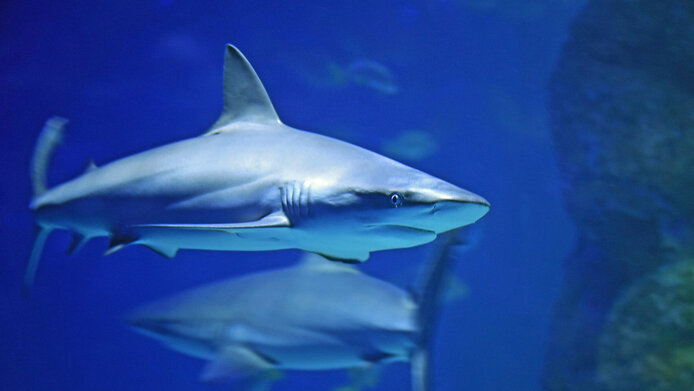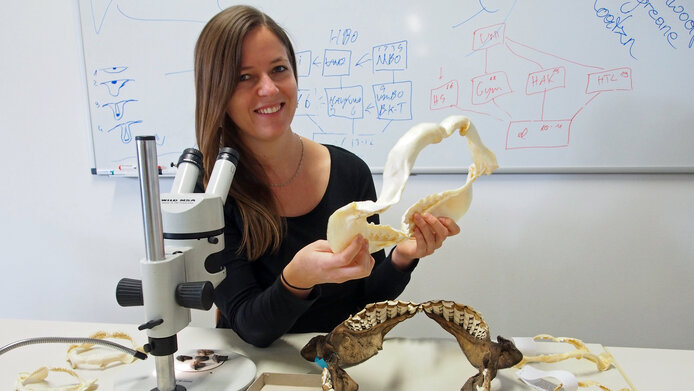Family tree research for species conservation

“If sharks become extinct, the entire food chain will collapse.” These are the warning words of Jürgen Kriwet, Professor at the Institute of Paleontology at the University of Vienna. With his team, he conducted the FWF-funded research project “Evolution and extinction risks of sharks, rays and skates”, which aims at providing more precise insights into the evolutionary tree of sharks, rays and skates – the last representatives of living cartilaginous fish. “We want to find out why these animals are so successful in evolutionary terms. Knowing this can also help us to make current conservation measures more targeted,” says Kriwet.
Sharks have been at the top end of the food chain for more than 200 million years, thereby making a significant contribution to maintaining the ecological balance. “Without sharks, the animals they feed on would multiply enormously and in turn overexploit their respective food sources,” says Kriwet. “This engenders a fatal cascading effect on the entire food chain, right down to the algae and protozoa.” For that reason, the researcher recommends protecting sharks in a more precise way, taking into account their long and complex evolutionary history.
“Shark species that have been around for longer are more resilient than short-lived species,” explains Kriwet. “The long-lived species have been more successful in adapting to changing environmental conditions. We believe that this will also help them cope with today's anthropogenic changes such as climate change and overfishing.”
But in order to improve protection methods, the researchers need to gain a more detailed understanding of the family tree of sharks. This can tell them which species are related and how long they existed – an endeavor that is easier said than done.
Personal details
Jürgen Kriwet conducts research at the Institute of Paleontology at the University of Vienna. With the research project Evolution and Extinction Risk of Sharks, Skates and Rays he is providing the scientific basis for improved species protection.
Unclear family relationships
The researchers face challenges such as the complexity of evolution and incomplete data. In order to close the gaps, they compare the physical characteristics of fossils and present-day creatures. The results enable them to draw conclusions about which animals are related over the length of history, as many characteristics are passed on from one species to the species evolving from it. When this information is collated with geological information about the age of the rock layer in which the fossils were found, an evolutionary family tree emerges.
The difficulty lies in the insufficient number of available fossils and in the fact that similar physical characteristics can develop in different species that are not closely related –a phenomenon known as convergent evolution. Dolphins and sharks, for instance, both have streamlined bodies to glide through the water, but they are not closely related.
Genetic fingerprinting was only developed in the early 1980s. Nowadays researchers can use DNA sequencing to compare the genetic information of different organisms and thus draw conclusions about their kinships. The more closely related two organisms, the more akin their genetic code. But again, this presents some challenges. A change in the genes does not always result in the emergence of a new species and DNA from long-extinct species is not available.
Moreover, these different methods produce different family trees, which are constantly subject to change due to new research insights. “In our project, we want to bring together the different approaches based on comparisons of fossils and living animals and DNA sequencing for the first comprehensive study of sharks, skates and rays,” is how Kriwet describes the intentions underlying his project.
Diverse teeth and sharks in the Mediterranean
Kriwet and doctoral students Julia Türtscher and Patrick Jambura employed a variety of different approaches to reach their goal. They analyzed the teeth and jaw shapes of current and fossil shark species in order to draw conclusions about their evolutionary history. With these animals, teeth play a special role because they are constantly growing back. As a result, they are often found in fossilized form, whereas the cartilaginous skeletons of sharks, skates and rays are generally not preserved. The shape of the teeth and jaws adapted as a function of environmental conditions and food sources over the course of evolution, which helps researchers to differentiate between species.
In this way, they found an extinct relative of the great white shark whose teeth and jaws tell them that it ate hard food such as shellfish. “This shows that this group around the great white shark used to be much more diverse,” notes Kriwet. “We were also able to demonstrate how the ancestors of the great white shark grew larger and larger over time.”
Doctoral student Patrick Jambura used new phylogenetic methods, including molecular genetic information, to merge the different phylogenetic trees resulting from comparing fossils and DNA sequencing. The resulting new phylogenetic trees describe both the relationships and the chronological sequence of shark species better than ever before.
Support from citizens furnishes a surprise
One particular aspect of this research is the collaboration with non-scientists as part of citizen science projects which report sightings of sharks, skates and rays. “We are working with colleagues in Croatia and Libya to gain better insights into the actual diversity of species in the Mediterranean,” says Kriwet. “We thus learned that the great white shark has been spotted off the coast of Libya several times in recent years. It had previously been assumed that it didn't even exist in the Mediterranean.”
With a wide range of methods, partners and also scientific publications, the research project was very successful. “We are very pleased to have received funding for this very ambitious basic research project,” says Kriwet. “It has already resulted in several follow-up projects and we are also working with the WWF to improve shark conservation based on our findings.”
Personal details
Jürgen Kriwet's passion for sharks began as a child. He studied geology and paleontology at the Free University of Berlin, completed his doctorate at the Humboldt University of Berlin and in 2010 was appointed Professor of Paleobiology at the Institute of Paleontology at the University of Vienna. With the research project Evolution and Extinction Risk of Sharks, Skates and Rays (2020-2025), which received funding from the Austrian Science Fund FWF, he is providing the scientific basis for improved species protection.
Publications
López-Romero F.A., Stumpf S., Kamminga P. et al.: Shark mandible evolution reveals patterns of trophic and habitat-mediated diversification, in: Communications Biology 2023
Villalobos-Segura E., Marramà G., Carnevale G. et al.: The Phylogeny of rays and skates (Chondrichthyes: Elasmobranchii) based on morphological characters revisited, in: Diversity, 2022
Türtscher J., López-Romero F.A., Jambura P.L. et al.: Evolution, diversity and disparity of the tiger shark lineage Galeocerdo in deep time, in Paleobiology 2021






